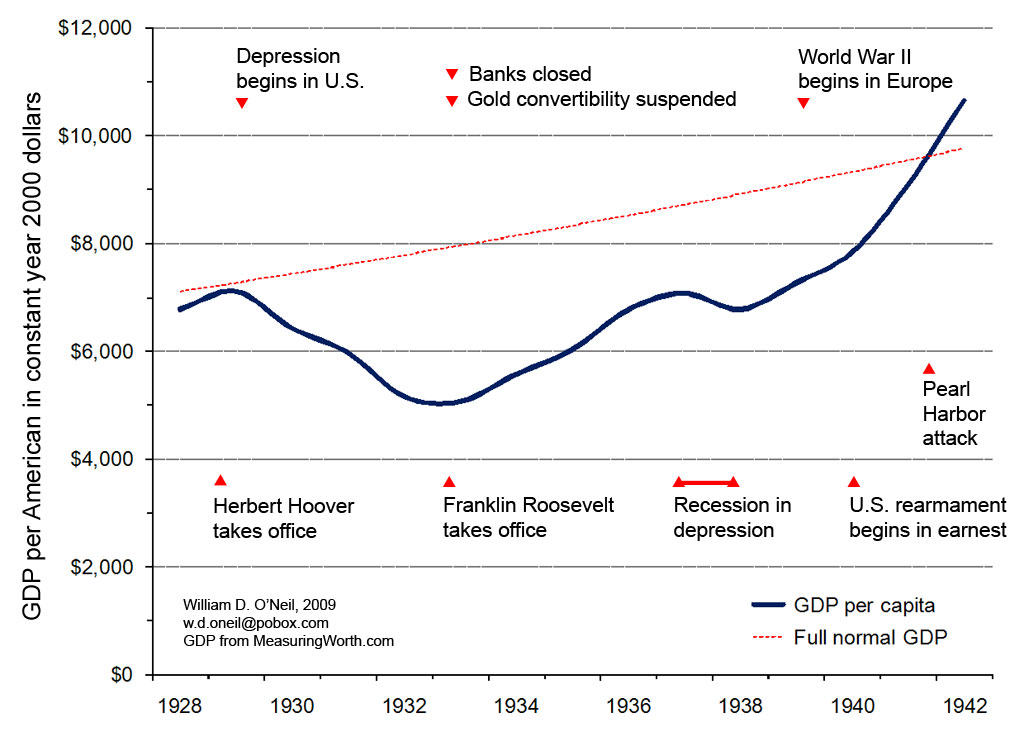
This began as a result of the current economic downturn, whose severity has evoked many comparisons and references to the Great Depression that started in 1929. I had read a number of papers and books on the Great Depression and was reasonably familiar with it, but I wanted to make sure I was on firm ground in thinking and speaking about it. In particular, I wanted to be sure I had the facts and figures right.
I was hearing many people make strong assertions about the Depression. Some of these I already knew to be false, some sounded very questionable, and some seemed to be very interesting and significant – if true. I wanted to sort out the factual basis for myself.
After I got started on this I decided that I would make the results available on my Web site as a sort of rough working paper. In part my purpose is to aid others who may be looking for information, but I also hope for replies telling me where I have erred, or overlooked important data. It has been a very hurried effort, certainly not complete and probably not entirely correct.
In most cases I’ve presented the data in graphical form, for easy comprehension of large data sets. At the end of the paper there is a section on “Methods and sources” which details where each data set comes from. It is not at all necessary to read the paper through from start to finish – it should be easy to pick and choose just what you’re interested in.
I have endeavored to present the data as they are, with a minimum of editorializing or analysis, except as absolutely necessary for comprehension, and no technical jargon. In the next-to-last section, “Where did it come from, and where did it go?” I very briefly summarize the views of economists on major issues. In “Some reflections,” at the end, I do a little light analysis.
This chart provides a little orientation to the Depression, showing average GDP per person (which equals average income) and some major events from 1928 to 1942. (As a point of reference, in 2000 the average per-capita GDP was $34,761. As of early 2009 it's somewhere close to $38,000 in 2000 dollars, or $47,000 in today's dollars.)

The Depression was worldwide. This chart shows GDP in international comparison.

Links to some sites for data about the Depression. (I've used data from these in the paper.)
The Census Bureau of Economic Analysis database of National Income and Product Accounts (NIPA) data from 1929 to the present: www.bea.gov/national/nipaweb/ . (Not all series extend back as far as the Depression.) U.S. Government site, free to the public.
MeasuringWorth: http://www.measuringworth.com/ . (Only a few series, so far, but covering a very wide time-span.) Free, but contribution requested if you find it valuable
Historical Statistics of the United States (HSUS) Millennial Edition Online: http://hsus.cambridge.org/HSUSWeb/ . (Broad coverage of many series, but not always in great depth of detail.) Pay site, so check to make sure the data you need aren't available elsewhere.
The Census archive of Statistical Abstracts of the United States from 1878 to 2005 in PDF form, as well as Historical Statistics of the United States: Colonial Times to 1970, Bicentennial Edition: http://www.census.gov/compendia/statab/past_years.html (Wonderful collection of data but you have to translate it to spreadsheet form yourself.) U.S. Government site, free to the public.
Federal Reserve Bank of St. Louis Federal Reserve Economic Data (FRED): http://research.stlouisfed.org/fred2/ . (With more than 20,000 data sets this is the first place economists look for current or historical data, but only selected series go back as far as the Depression. It will draw graphs for you.) Federal Reserve System site, free to the public.
FRB of St. Louis Federal Reserve Archival System for Economic Research (FRASER) publications page: http://fraser.stlouisfed.org/publications/ . (The PDF of Banking and Monetary Statistics, 1914-1941 is immensely valuable for the Depression, but again you have to translate the data to spreadsheet form yourself.) Federal Reserve System site, free to the public.
© 2009 by William D. O'Neil
26 Feb 2009, added material 25 Apr 2010